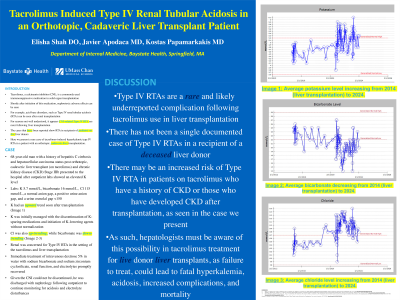Tuesday Poster Session
Category: Liver
P4752 - Tacrolimus-Induced Type IV Renal Tubular Acidosis in an Orthotopic, Cadaveric Liver Transplant Patient
Tuesday, October 29, 2024
10:30 AM - 4:00 PM ET
Location: Exhibit Hall E

Has Audio
- ES
Elisha Shah, DO
Baystate Medical Center
Springfield, MA
Presenting Author(s)
Elisha Shah, DO1, Javier Apodaca, MD2, Kostas Papamarkakis, MD3
1Baystate Medical Center, Springfield, MA; 2UMass Chan Medical School, Baystate Medical Center, Springfield, MA; 3Baystate Medical Center, East Granby, CT
Introduction: Tacrolimus, a calcineurin inhibitor (CNI), is a commonly used immunosuppressive medication in solid organ transplantation. Shortly after initiation of this medication, nephrotoxic adverse effects can be seen. For example, acid-base disorders, such as Type IV renal tubular acidosis (RTA) can be seen after renal transplantation. For reasons not well understood, it appears CNI-related Type IV RTA are rarer following liver transplantation. RTAs post-liver transplantation have only been reported in recipients of pediatric or live liver donors. Here we present a rare case of tacrolimus-induced hyperkalemic type IV RTA in an adult patient with an orthotopic, cadaveric liver transplantation.
Case Description/Methods: A 68-year-old man with a history of hepatitis C cirrhosis and hepatocellular carcinoma status post orthotopic, cadaveric liver transplant (on tacrolimus) and chronic kidney disease (CKD) Stage IIIb presented to the hospital after outpatient labs showed an elevated potassium (K) level. He was found to have a K of 5.7 mmol/L, bicarbonate of 16 mmol/L, chloride (Cl) of 115 mmol/L, a normal anion gap, a positive urine anion gap, and a urine osmolal gap of less than 150. On further chart review, his K had an upward trend soon after transplantation; this was initially managed with the discontinuation of K-sparing medications and initiation of K-lowering agents without normalization. Cl was also up-trending, while bicarbonate was down-trending. Renal was concerned for Type IV RTA in the setting of the tacrolimus and liver transplantation. With immediate treatment of intravenous dextrose 5% in water with sodium bicarbonate and sodium zirconium cyclosilicate, renal function, and electrolytes promptly recovered. Given the CNI could not be discontinued, he was discharged with nephrology following outpatient to continue monitoring for acidosis and electrolyte disturbances.
Discussion: Type IV RTAs are a rare and likely underreported complication following tacrolimus use in liver transplantation. There has not been a single documented case of Type IV RTAs in a recipient of a deceased liver donor. There may be an increased risk of Type IV RTA in patients on tacrolimus who have a history of CKD or those who have developed CKD after transplantation, as seen in the case we present. As such, hepatologists must be aware of this possibility in tacrolimus treatment for deceased donor liver transplants, as failure to treat, could lead to fatal hyperkalemia, acidosis, increased complications, and mortality.
Disclosures:
Elisha Shah, DO1, Javier Apodaca, MD2, Kostas Papamarkakis, MD3. P4752 - Tacrolimus-Induced Type IV Renal Tubular Acidosis in an Orthotopic, Cadaveric Liver Transplant Patient, ACG 2024 Annual Scientific Meeting Abstracts. Philadelphia, PA: American College of Gastroenterology.
1Baystate Medical Center, Springfield, MA; 2UMass Chan Medical School, Baystate Medical Center, Springfield, MA; 3Baystate Medical Center, East Granby, CT
Introduction: Tacrolimus, a calcineurin inhibitor (CNI), is a commonly used immunosuppressive medication in solid organ transplantation. Shortly after initiation of this medication, nephrotoxic adverse effects can be seen. For example, acid-base disorders, such as Type IV renal tubular acidosis (RTA) can be seen after renal transplantation. For reasons not well understood, it appears CNI-related Type IV RTA are rarer following liver transplantation. RTAs post-liver transplantation have only been reported in recipients of pediatric or live liver donors. Here we present a rare case of tacrolimus-induced hyperkalemic type IV RTA in an adult patient with an orthotopic, cadaveric liver transplantation.
Case Description/Methods: A 68-year-old man with a history of hepatitis C cirrhosis and hepatocellular carcinoma status post orthotopic, cadaveric liver transplant (on tacrolimus) and chronic kidney disease (CKD) Stage IIIb presented to the hospital after outpatient labs showed an elevated potassium (K) level. He was found to have a K of 5.7 mmol/L, bicarbonate of 16 mmol/L, chloride (Cl) of 115 mmol/L, a normal anion gap, a positive urine anion gap, and a urine osmolal gap of less than 150. On further chart review, his K had an upward trend soon after transplantation; this was initially managed with the discontinuation of K-sparing medications and initiation of K-lowering agents without normalization. Cl was also up-trending, while bicarbonate was down-trending. Renal was concerned for Type IV RTA in the setting of the tacrolimus and liver transplantation. With immediate treatment of intravenous dextrose 5% in water with sodium bicarbonate and sodium zirconium cyclosilicate, renal function, and electrolytes promptly recovered. Given the CNI could not be discontinued, he was discharged with nephrology following outpatient to continue monitoring for acidosis and electrolyte disturbances.
Discussion: Type IV RTAs are a rare and likely underreported complication following tacrolimus use in liver transplantation. There has not been a single documented case of Type IV RTAs in a recipient of a deceased liver donor. There may be an increased risk of Type IV RTA in patients on tacrolimus who have a history of CKD or those who have developed CKD after transplantation, as seen in the case we present. As such, hepatologists must be aware of this possibility in tacrolimus treatment for deceased donor liver transplants, as failure to treat, could lead to fatal hyperkalemia, acidosis, increased complications, and mortality.
Disclosures:
Elisha Shah indicated no relevant financial relationships.
Javier Apodaca indicated no relevant financial relationships.
Kostas Papamarkakis indicated no relevant financial relationships.
Elisha Shah, DO1, Javier Apodaca, MD2, Kostas Papamarkakis, MD3. P4752 - Tacrolimus-Induced Type IV Renal Tubular Acidosis in an Orthotopic, Cadaveric Liver Transplant Patient, ACG 2024 Annual Scientific Meeting Abstracts. Philadelphia, PA: American College of Gastroenterology.
